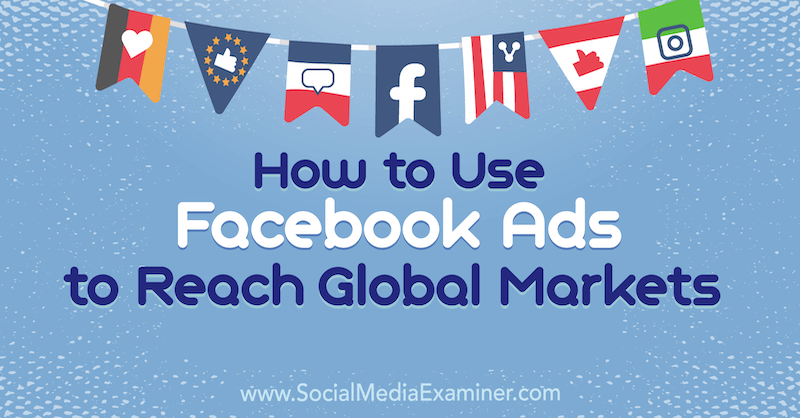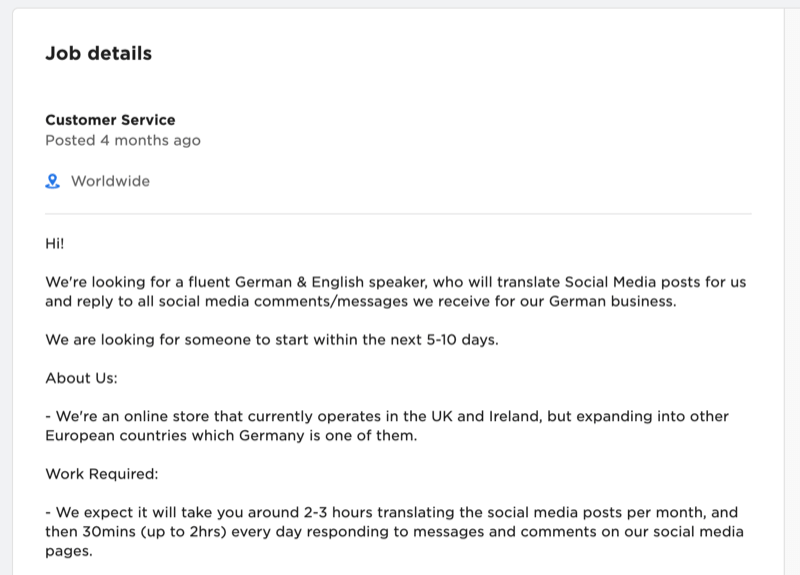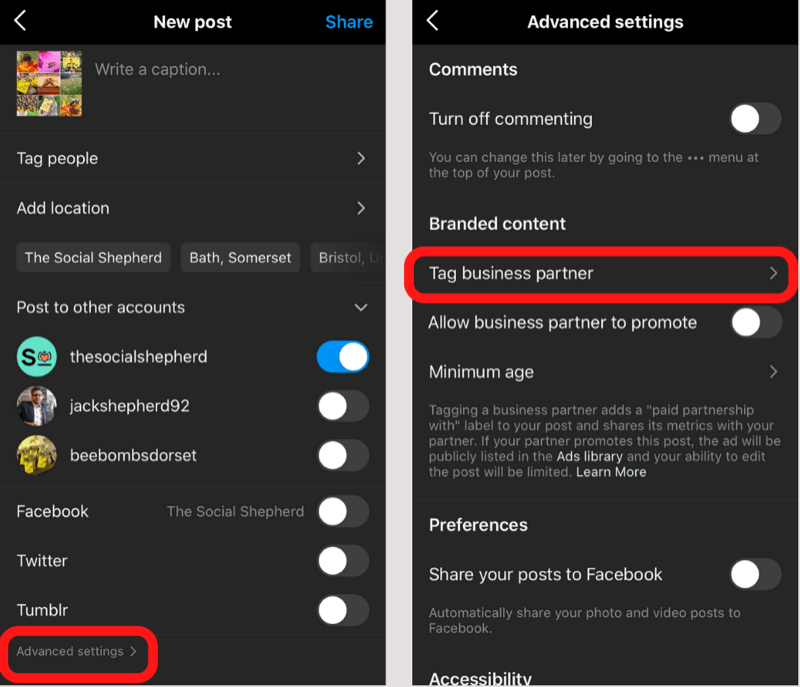Need to reach a global audience? Wondering how to scale your Facebook ads across countries and languages?
In this article, you’ll find tips to optimize your Facebook and Instagram ads campaigns for international audiences.

#1: Translate Your Facebook Ads for Local Markets
You probably have existing Facebook campaigns that are operating well in one country so you don't want to upset what's already working by adding new ad sets or even tweaking existing ad sets. To scale a campaign, duplicate it and translate the ads directly within Ads Manager.
At the ad level, you'll see a Languages section, which allows you to add your own translations or use Facebook's automatic translations.

After you click on Add Languages, you'll see a field where you can search for languages to add. Select the language you want to translate your ads into.

You'll also need to decide whether to go with an automatic translation or upload your own. Both options allow you to edit the website URL, headline, primary text, and description. Once you've created your ad in multiple languages, it will automatically appear in those languages to people who speak them.
If you're working on a smaller budget and want to test lots of territories quickly, automatic translation can be a viable option. That said, it's best to upload your own translations if you have access to a fluent translator so the translation will be as accurate as possible.
Additionally, if you're translating ads into another language, having the ability to respond to comments and DMs in that language is also a must for any international campaign.
If your business doesn't have someone fluent in the target country's language, consider hiring a freelance translator. This person could monitor and reply to user comments and translate new ad copy as needed. Not only does this approach help convert more people into customers but it also builds a stronger community with the audience you're trying to reach.
Here's an example of a job posting for a freelance translator:

Get World-Class Marketing Training — All Year Long!
Are you facing doubt, uncertainty, or overwhelm? The Social Media Marketing Society can help.
Each month, you’ll receive training from trusted marketing experts, covering everything from AI to organic social marketing. When you join, you’ll also get immediate access to:
- A library of 100+ marketing trainings
- A community of like-minded marketers
- Monthly online community meetups
- Relevant news and trends updates
On sites like Upwork, you can typically find freelancers for around $10/hour, which can be a small price to pay for the ability to scale your campaigns globally. When you receive applications, I recommend narrowing your options to the three best freelancers and then conduct video interviews to ensure they align with your brand and values.
After you've chosen the right freelancer for your business, create a Google sheet to share with them to allow easy translations. You'll also need to invite them into your Facebook Business Manager to give them access to your Facebook page and Instagram profile.
Pro Tip: Consider asking your translator to also manage your Facebook page inbox and Instagram DMs. Prepare an in-depth FAQ so they can easily reply to messages with responses to questions they're likely to receive.
#2: Structure of Your Facebook Ad Campaign for Global Scaling
When scaling into new territories, it's crucial to have your Facebook campaign structure set up correctly.
The first step is to outline your full funnel including the top, middle, and bottom of the funnel.
After you've set up your funnel and trained the pixel, set up a campaign that allows Facebook's AI to optimize delivery to the entire funnel, meaning you'll have zero exclusions in each ad set. This allows Facebook to optimize toward pockets of audiences in all of the countries inside the campaign, targeting people with the highest opportunity to convert. Set your country targeting to every country you want to run ads in.
Next, group your Facebook campaigns by countries that share similar cultural values. People across the world have different ways of living and motivations to convert so it's important to personalize your ad creatives, copy, and messaging to appeal to them. This also helps to create a simplified account structure, which is one of Facebook's recommendations in their Power 5.
Rather than set up separate campaigns for each country you're marketing in, I recommend you structure your campaigns as follows.
Start by grouping all of the countries in one campaign with three ad sets for each country:
- No targeting (18-65+, women and men)
- Interests stacked
- Lookalikes stacked
I recommend testing this approach first. If you don't get the results you're looking for, try grouping countries by language/domain with the same three ad sets recommended above. For example:

Discover Proven Marketing Strategies and Tips
Want to go even deeper with your marketing? Check out the Social Media Marketing Podcast! Publishing weekly since 2012, the Social Media Marketing Podcast helps you navigate the constantly changing marketing jungle, with expert interviews from marketing pros.
But don’t let the name fool you. This show is about a lot more than just social media marketing. With over 600 episodes and millions of downloads each year, this show has been a trusted source for marketers for well over a decade.
- Germany and Austria
- America and Canada
- Australia and New Zealand
Both approaches to structuring your campaigns allow you to maximize Facebook's machine learning, as you keep ad sets and audiences as large as possible to allow for maximum scaling.
Pro Tip: Localize your website to reflect the currencies you accept to ensure a smooth customer journey. Relying on your customer to use a language and currency converter just doesn't cut it anymore, especially when those apps use Google Translate, which can often be wrong.
Creating a separate website or subdomain for each country can help increase your conversion rate. For instance, Shopify has pages for .com, .co.uk, .es, and .fr. Also make sure you show the product in the consumer's currency on both the product page and checkout page.
#3: Leverage Branded Content From Local Influencers
When entering a new country, a good way to scale your marketing reach is to partner with influencers who have fewer than 10,000 followers on Instagram but are willing to post content on their feed and story in exchange for a free product.
To find potential influencers to partner with, research relevant hashtags on Instagram. Let's say you want to find fitness influencers in Germany. First research hashtags relevant to your industry or that you've already used on your main page.
The word “workout” in German is “trainieren,” so type “#trainieren” into Instagram search. Look at the top posts, which will be the most engaged posts recently published with that hashtag.

Look for active influencers from the country you're targeting. Once you've researched 5-10 Instagram hashtags, you should have a list of potential influencers to collaborate with. Work with your translator to reach out to them and propose a partnership.
Once an influencer has agreed to collaborate with you, draft an influencer contract for them to sign. It should include:
- A list of the products they'll receive
- What the influencer is required to post (including the type of content and examples of previous posts you liked)
- Any phrases they should include (or exclude) when mentioning your brand
- How you expect to be tagged or mentioned in the influencer's posts
- Links to all of your social media accounts
- Language that gives you media rights to the content, for use on paid social, your website, and any digital platform
Branded content can work at every stage of the funnel depending on the style of content the influencer created for you. But typically, a product shot works well at the top of the funnel while a testimonial/review video is effective at the middle and bottom of your funnel.
In addition to using influencer content on your page, you can set up Instagram Branded Content with the influencer. This feature lets you run Facebook ads under the influencer's Instagram account. This approach builds even more social proof with potential customers because the ad is delivered from the creator's personal account rather than a branded business account.
There are two ways to set up branded content on Instagram.
The first is to open your Instagram profile and navigate to Settings > Business > Branded Content > Request Ad Creation Access > Search and select the Instagram account you want to connect to.

The second is to have the influencer tag you as a business partner when they create their post in the feed or a story.

Conclusion
There are many ways to scale your business with Facebook ads, but when entering new international markets, focus on how you can personalize the customer journey from the first moment they see your ad to purchase. You need to consider language, cultural differences, and currency to see optimal results.
Using native language in your Facebook ads will put consumers at ease and build trust, which in turn will help increase your CTR and conversions.
What do you think? Which of these tactics will you try when scaling your campaigns globally? Share your comments below.
More articles on Facebook ads:
- Discover vertical Facebook ad scaling and horizontal Facebook ad scaling methods that drive more leads and sales.
- Find out what to do if your Facebook ads get rejected.
- Learn how to test your Facebook ads for optimal results.
Attention Agency Owners, Brand Marketers, and Consultants

Introducing the Marketing Agency Show–our newest podcast designed to explore the struggles of agency marketers.
Join show host and agency owner, Brooke Sellas, as she interviews agency marketers and digs deep into their biggest challenges. Explore topics like navigating rough economic times, leveraging AI, service diversification, client acquisition, and much more.
Just pull up your favorite podcast app, search for Marketing Agency Show and start listening. Or click the button below for more information.

